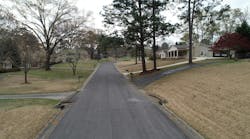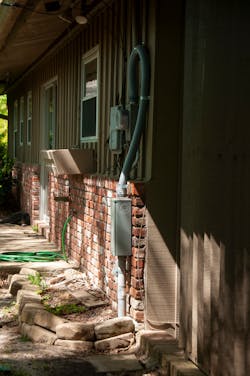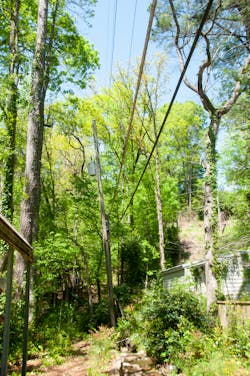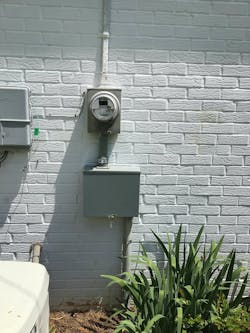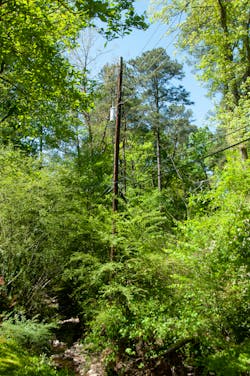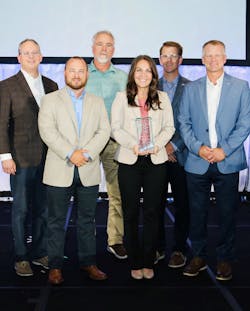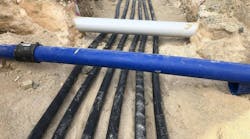Alabama Power seeks to continuously improve service and reliability in communities across the state. We are now more connected than ever both at home and work, and these enhancements are increasingly important to better serve 1.5 million Alabama homes, schools, businesses, and industries that depend on us. The Green Valley Distribution Underground project is one example of how Alabama Power is investing in Alabama.
Historically, distribution lines have only been installed underground when a customer was willing to pay the differential upfront cost between the underground installation and the overhead installation. However, the world around us has changed. Costs to maintain reliable overhead service to customers, like vegetation management, have increased. In some cases, lines now have restricted access due to the development patterns of older residential areas. Restricted accessibility results in longer restoration times for customers.
Undergrounding for Better Service
The Central Engineering Undergrounding Program uses system outage and maintenance cost data to identify existing overhead distribution lines that would be beneficial to underground, thus upgrading our power grid’s infrastructure to decrease the number and length of power outages experienced by customers.
The Central Engineering Green Valley project is an example of converting an aged, access-constrained overhead line to a roadside-underground line resulting in improved reliability and reduced future maintenance costs. The existing overhead distribution line was constructed in the 1960’s during the early stages of the Green Valley Residential development. Over the years, lots were developed with homes, fences, sheds, landscaping, and various other common residential property features. Restricted easement access in an established residential area with mature vegetation requires manual tree trimming using climbers on a more frequent cycle than easements that can be accessed with machinery and buckets. This can increase routine maintenance costs.
The goal of the Green Valley Distribution Underground Project was to remedy those challenges by relocating the rear-lot overhead distribution system to a front-lot underground distribution system. The front lot underground system was installed along the front of customer properties along a combination of newly obtained private and municipality right of way. Relocating the distribution system in this manner upgraded Alabama Power grid’s infrastructure, decreasing the number and length of power outages experienced by customers.
The Green Valley undergrounding project was a challenge from both a size and complexity perspective. Approximately 8,000 feet of overhead was located rear of customer properties serving 101 separate meters. Relocating the line would require a new property easement from each landowner. Educating the customer quickly became a necessary goal to ensure customer satisfaction and buy in.
Two weeks prior to fielding, letters were sent to property owners informing them of the up-coming project, providing them with a point of contact and advanced notice that field personnel would soon be in their area gathering field notes for design purposes. Next, individual appointments were established with customers to discuss the project’s reliability benefits and its construction and facilities footprint on their property.
Keeping Customers Happy
Customer engagement was very high. Green Valley is a residential area with a diverse demographic including young families, retirees, and work at home professionals. Primary concerns heard from customers were associated with limiting the footprint of construction, and Alabama Power’s commitment to restore their property to its original quality prior to any construction taking place. These asks were answered by reviewing and editing design where possible, using specialized equipment and construction practices, and agreements to make repairs associated with construction activities.
Customer service was a top priority and relationships with our customers were critical to the success of this project. The customer interaction on the Green Valley project played a part in several standard undergrounding public relations materials that are currently an integral part of the Central Engineering Program.
These standard materials have not only served as educational resources for the customers, but also educating other departments within Alabama Power, such as the customer call center, statewide management, district field employees and several others.
Getting With the Program
Internal education to all the departments within Alabama Power with first line of communication with customers allows them to be knowledgeable about the Central Engineering Program, its mission, and the benefits it is providing to the grid and our customer base. Program educational resources resulting from this project that are now a standard practice on each Central Engineering underground project are provided via multiple medias such as personally addressed letters to customers effected, post cards, door knockers, and an externally accessible website.
Each resource contains direct contact information to a monitored undergrounding email inbox or a project manager associated with a project. These educational resources also serve as a conduit for information to come back into the program such as customer feedback and questions.
In addition to internal program education efforts, the Central Engineering public relations materials were critical in spreading the message about the underground program to key community contacts and third-party entities associated with or effected by the projects in their area.
Educating customers, internal leadership and workgroups, and Alabama Power community partners has served as a strong platform for program discussion, feedback, efficiencies, and as an opportunity for partnership across all those entities.
Meeting Terrain Challenges
The combination of dealing with 100 landscaped, compact yards over various types of challenging terrain and removing rear-lot overhead facilities required innovative equipment, such as compact boring equipment, rock-boring head adapters, all-terrain boring rigs and rear-lot machines. Diversifying contracted construction equipment allowed for boring in tighter spaces or when encountering rock, where traditional trenching is not an option.
The all-terrain equipment also offered an alternative means of limiting the footprint of construction on a customer’s property, which was a helpful option for navigating manicured yards, paved driveways, carports, sheds and other access-limiting factors. Rear-lot machines were used for removing the existing overhead line from customers’ confined backyards.
While this equipment is not necessarily practical for all day-to-day work, it certainly has times when it adds value, and this project was an example of one of those times. The engineering team used this experience with the innovative equipment for the design and planning of other projects similar to Green Valley.
Construction’s use of the innovative equipment provided an opportunity to learn the equipment and apply seasoned judgment around when to implement it into the construction of a project.
Underground Engineering
Converting the overhead customer services to underground service entrances came with its own set of challenges and opportunities for innovation. Three types of conversion kits were supplied and installed at no cost to the customer. The type of conversion kit used by construction varied by the location and available space around the customer’s existing service entrance.
Service entrances that could not be converted – due to lack of room for a conversion kit at the service point – were left with overhead service fed from an inverted secondary riser pole.
Other factors that played into leaving services overhead were customer preference or presence of outdoor lighting. The various customer service entrance conversion cases were another part of the construction process that required detailed and constant communication between the design team, construction team, and the customer being affected.
In addition, by moving underground the most difficult-to-access and outage-prone line segments, our line crews can focus on other areas after major storms, thus reducing restoration time for all customers. The underground cable was installed in high-density polyurethane conduit adding a dig-in barrier and providing for efficient future maintenance and operation of the system.
Installing an underground distribution system serving 101 active meters across 100 separate properties, needing 100 separate easements. Design and construction navigated many limitations, such as property easement constraints, tight workspaces, various challenging terrains and converting customer service entrances.
The technical complexity, various construction challenges and detailed customer involvement were navigated by a comprehensive design, innovative construction means and methods, and an unwavering dedication to customer satisfaction.
Improved Performance
Approximately 8,000 feet of hard-to-access, overhead distribution line built in the 1960s was removed from the rear-lot of customer properties. The project lasted 18 months from preliminary
concept to construction completion.
Green Valley project customers have experienced improvement in customer minutes of interruption (CMI) and in customers interrupted (CI) since construction completion in April 2022. Both metrics directly correlate to improved outage duration (SAIDI) and frequency (SAIFI).
In conclusion, the Green Valley Distribution Underground project was successful in converting an overhead distribution line with limited access to an accessible underground distribution line reducing the number and duration of outages and reducing future system maintenance costs.
In addition to the Green Valley project, approximately 240 other central engineering undergrounding projects have been completed and hundreds like it are being designed. As one of the first for the company, the knowledge and experience gained on this project has shaped central engineering undergrounding best practices from the undergrounding guidelines document to day-to-day decisions in the field.
Holly Joiner has 13 years of power delivery distribution experience with Alabama Power. She currently serves as the connectivity supervisor for APC’s Fiber To Distribution program. Previously, Joiner was a central engineering underground coordinator for APC’s Strategic Underground Program.
Editor’s Note: This project was the 2023 S.E.E. Industry Excellence Award Winner in the Distribution Category.
